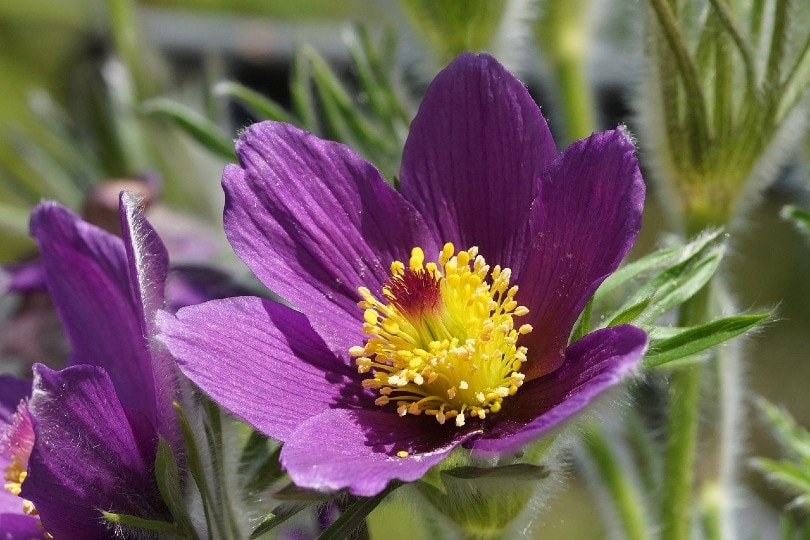What Is the State Flower of South Dakota? History, Uses & FAQ
-

- Last updated:

Emerging as “that bold bit of life at the edge of the snows,” as poet Badger Clark described it, the American pasque is one of South Dakota’s earliest signs of spring. The purple wildflower blooms as early as March, presenting a dazzling display of color against an otherwise lifeless landscape in the waning winter months. As the ultimate herald of seasonal renewal across South Dakota’s prairies, it became the official state symbol in 1903.
Beautiful and resilient, the pasque boasts a rich history and deep meaning for the people and wildlife of South Dakota. Let’s learn more about this celebrated state flower and why it is essential to the state’s culture.
What Is the South Dakota State Flower?
The perennial pasque flower (Pulsatilla hirsutissima) is a member of the buttercup family. It grows 6–12 inches tall and 1–4 inches wide. The showy bloom consists of 5–8 sepals around a cluster of contrasting bright yellow stamens. Sepals typically range from pale to deep purple but can also turn white, blue, pink, or red.
A whorl of three linear leaves attached directly to the stem sits below the flower. A few basal leaves growing long petioles develop when the flowers open. Silvery-white hairs covering the stem, leaves, and bud serve as insulation for the plant in its naturally frigid habitat.
Flowers bloom for roughly two weeks, and the peduncle stretching above the whorled leaves expands past the sepals as they die off. The plant’s leaves also continue growing. Meanwhile, the collection of silver and purple styles amidst the stamens at the center of the sepals elongate to overtake the head of the plant.
The seed head eventually takes on a dandelion-like look, with long plumes creating a fluffy ball atop the stalk. These feathery forms allow the seeds to travel on wind currents. The wind-caught seeds give the flower several nicknames, including the windflower and prairie smoke.

American Pasque Growing Habits
The American pasque has several other monikers to clue you into its native locations and flowering season. Some of its most popular nicknames include the May Day flower, Easter flower, prairie crocus, and sand flower. The name “pasque” itself is an Old French term for Easter, the time when the bell-shaped flower blooms.
As one of the first signals of the emergent spring season, the flower sometimes grows even before the snow has finished melting. It can be challenging to spot. Growing low to the ground protects the flower from the cold winds, so you’ll often see it barely peeking above the snow or surrounding prairie grasses.
The typical flowering period runs from April through May. Location factors into when you can expect the pasque’s two-week-long blooms. It grows early across the state’s plains and prairies, but blooming can extend into June in the mountain meadows of the Black Hills.
Preferring cool, moist conditions, the American pasque flower is a hardy species that grows as far north as Alaska. In South Dakota, it primarily resides in plains, meadows, and foothills east of the Missouri River. Its distribution has dwindled as agriculture and ranching took over much of the state because it only grows in native plains.
American Pasque Uses and Toxicity
The entire pasque plant is poisonous when fresh. Like other buttercup varieties, the plant contains a volatile compound called protoanemonin. The oil can cause adverse reactions topically, particularly blistering. It has considerable gastrointestinal side effects, including diarrhea, vomiting, nausea, and mouth pain. In extreme cases, ingestion can cause paralysis or even death.
Despite its toxicity, numerous cultures have made good use of the American pasque for medicinal purposes. When the flower dries, the protoanemonin contained therein breaks down into anemonin, a nontoxic anti-inflammatory compound. Native Americans used the dried pasque leaves to relieve pains from rheumatism and headaches and the roots for treating lung conditions.
Early European and Asian cultures also discovered unique medicinal applications for the pasque. One of its most popular uses is for treating cataracts, glaucoma, and other eye diseases. As an ornamental plant, it makes a beautiful addition to rock gardens and can even adapt to xeriscaping arrangements.
How Was the State Flower Chosen?
South Dakota established the law instating the pasque as its official flower in 1903. It didn’t adopt any additional symbols until 1943 when it took on its “Hail South Dakota” song and its state bird, the ring-neck pheasant. The state hadn’t even established a flag when it announced its state flower, and it would go another six years before finally doing so in 1909.
The pasque may not be the country’s first state flower, but it distinguishes itself as the only state emblem accompanying a motto. The South Dakota Education Association championed the cause to adopt the pasque alongside the motto “I Lead,” and Governor Charles Herreid signed it into law on March 5. In 1919, the legislature changed the scientific name to Pulsatilla hirsutissima.
Conclusion
The American pasque has always been a challenge to spot, given its inconspicuous growth and unpredictable timing. Unfortunately, it has only become a rarer sight over the years as development has led to the destruction of many of its natural habitats. As the state flower, it has protections under the law, and dedicated conservation groups are doing their part to preserve this spirited symbol of South Dakota heritage.
Featured Image Credit: joerngebhardt68, Shutterstock
Contents

